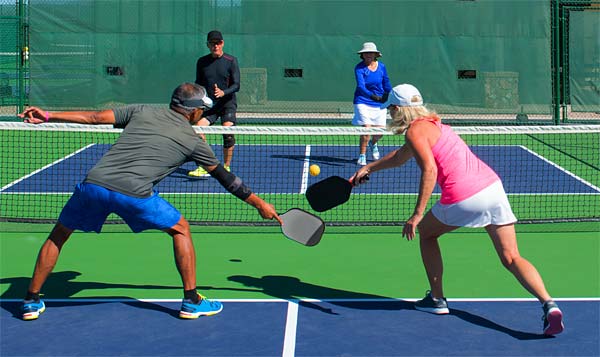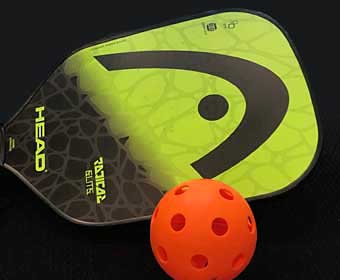What Is Pickleball?

A game for players ages 8 to 80+

Pickleball is a popular racquet sport that combines elements of tennis, badminton, and ping-pong. It is played with a paddle and a plastic ball on a court that is similar in size to a badminton court.
Pickleball was invented in 1965 by three friends in Bainbridge Island, Washington, who were looking for a new game to play with their families. The game quickly grew in popularity, and today there are over 3 million players in the United States alone.
Pickleball, a paddle sport that combines elements of tennis, badminton, and table tennis, has experienced a remarkable surge in popularity and growth in the United States in recent years. Originally invented in the mid-1960s, pickleball remained relatively obscure until the early 2000s when its popularity began to skyrocket. Today, it has become one of the fastest-growing sports in the country, captivating people of all ages and skill levels.
One of the key factors contributing to pickleball's popularity is its accessibility. The sport can be played on a smaller court, about one-third the size of a tennis court, and with lightweight paddles and a plastic ball with holes. This makes it easier for beginners to learn and participate, as it requires less physical exertion and offers a shorter learning curve compared to other racquet sports. The rules are also relatively simple, allowing new players to quickly grasp the basics and start enjoying the game.
Another reason for pickleball's growth is its appeal to a wide demographic. While it initially gained traction among older adults seeking a low-impact alternative to traditional sports, pickleball has successfully attracted players of all ages. Its social and inclusive nature fosters a sense of community, making it an excellent choice for families, friends, and even competitive athletes. The sport's versatility allows for casual, recreational play or intense, fast-paced matches, catering to the diverse preferences of its participants.
Pickleball's rise in popularity can also be attributed to the increasing availability of dedicated courts and organized leagues. Many communities across the United States have recognized the demand for pickleball facilities and have responded by constructing dedicated courts in parks, recreation centers, and retirement communities. This infrastructure development has further fueled interest in the sport and provided opportunities for players to connect, compete, and improve their skills. Moreover, pickleball tournaments and events have proliferated, offering players of all levels a chance to showcase their abilities and engage in a vibrant and competitive atmosphere.
Additionally, pickleball has gained considerable media exposure, with televised matches, online streaming platforms, and social media communities dedicated to the sport. The accessibility of content and the ability to watch top-level play has contributed to the spread of pickleball's popularity and inspired enthusiasts to pick up a paddle and try the game for themselves. As a result, pickleball has transcended its niche status and entered the mainstream consciousness, attracting a broader audience and generating interest from both recreational players and professional athletes.
In conclusion, pickleball's popularity and growth in the United States can be attributed to its accessibility, broad appeal, expanding infrastructure, and increased media coverage. As more people discover the fun and engaging nature of the sport, its community continues to expand, creating a thriving environment for players across the country. With its unique blend of competitiveness, social interaction, and ease of play, pickleball shows no signs of slowing down, positioning itself as a beloved and enduring sport in the United States and beyond.
The game is played on a court that is 20 feet wide and 44 feet long, with a net in the middle that is 36 inches high at the sidelines and 34 inches high at the center. The game is typically played in doubles, but it can also be played in singles.
The game starts with a serve, which is underhand and must clear the net and land in the opponent's service court. The receiving team must let the ball bounce before returning it, and then the serving team must also let the ball bounce before returning it. After the ball has bounced on both sides, the ball can be returned without bouncing.
Points are scored when the opposing team fails to return the ball, hits the ball out of bounds, or commits a fault, such as stepping into the non-volley zone. The first team to reach 11 points, with a lead of at least two points, wins the game.
One of the unique aspects of pickleball is the non-volley zone, which is a 7-foot area on either side of the net where players are not allowed to hit the ball before it bounces. This area is also known as the "kitchen."
Pickleball is a great sport for all ages and skill levels, as it can be played at a slower pace for beginners or at a faster pace for more experienced players. It also provides a great workout, as it involves a lot of movement and quick reflexes.
Pickleball is a fun and exciting sport that combines elements of tennis, badminton, and ping-pong. With its growing popularity and accessibility, it is no wonder that more and more people are picking up a paddle and joining in on the fun.
In the early days of the game, the average age of players was around 70. As pickleball gained popularity, its appeal was noticed by younger generations. Their enthusiastic participation was responsible for dropping the average age to around 40, and it continues to drop. Most of the top players in the world are in their late teens to late twenties.
